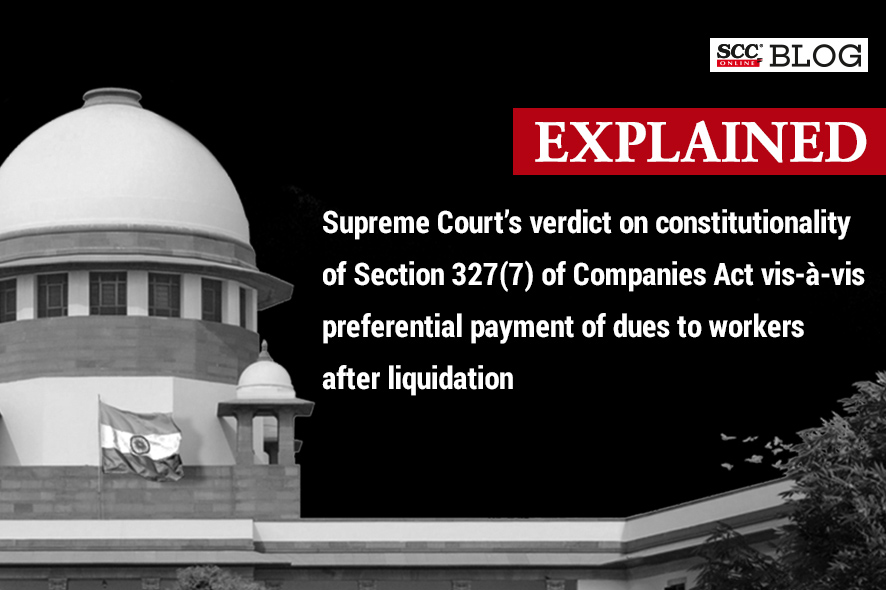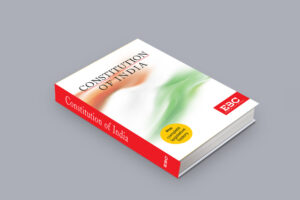Supreme Court: In batch of writ petitions filed for striking down Section 327(7) of the Companies Act, 2013 (‘Act, 2013’) as arbitrary and violative of Article 21 of the Constitution of India and for directing the respondents to leave the statutory claims of the “workmen dues” out of the purview of waterfall mechanism under Section 53 of the Insolvency and Bankruptcy Code, 2016 (‘IBC’)., the division bench of M.R. Shah* and Sanjiv Khanna JJ. has held that Section 327(7) of the Act, 2013 cannot be said to be arbitrary and/or violative of Article 21 of the Constitution of India as this Section provides that Sections 326 and 327 of the Act, 2013 shall not be applicable in the event of liquidation under the IBC, which has been necessitated in view of the enactment of IBC and it applies with respect to the liquidation of a company under the IBC. Further, it was held in case of the liquidation of a company under the IBC, the distribution of the assets shall have to be made as per Section 53 of the IBC subject to Section 36(4) of the IBC, in case of liquidation of company under IBC.
The Court said that as per Section 327(7), Sections 326 and 327 of the Act, 2013 shall not be applicable in the event of liquidation under the IBC. Sections 326 and 327 of the Act, 2013 provide for preferential payments in winding up under the provisions of the Act, 2013. However, in view of the introduction of the new regime under the IBC, in case of liquidation under IBC, distribution is to be made as per Section 53 of IBC. Thus, the Court noted that IBC has been enacted w.e.f. 28-05-2016 and as per Section 53 of the IBC, the distribution of assets in case of liquidation under the IBC is required to be made.
In view of the enactment of IBC and Section 53 of the IBC, the Court said that it was necessary to amend the Act, 2013.The object and purpose of amending the Act, 2013 and to exclude Sections 326 and 327 in the event of liquidation under the IBC was that there may not be two different provisions with respect to winding up/liquidation of a company. Therefore, in view of the enactment of IBC, it necessitated to exclude the applicability of Sections 326 and 327 of the Act, 2013 which cannot be said to be arbitrary.
After examining Section 53 of the IBC, the Court said that it provides for distribution of the assets in case of liquidation of a company under IBC. As per Section 53(1)(b) the workmen’s dues for the period of twenty-four months preceding the liquidation commencement date shall rank equally between the workmen and the secured creditor, in the event such secured creditor has relinquished security in the manner set out in Section 52. Therefore, workmen dues for the period of twenty-four months preceding the liquidation commencement date shall have pari passu with the dues of secured creditor.
The Court noted that as per Section 36(4) of IBC, all sums due to any workman or employee from the provident fund, the pension fund and the gratuity fund shall not be included in the liquidation estate assets and shall not be used for the recovery in the liquidation. Therefore, the same cannot be said to be arbitrary and violative of Article 21 of the Constitution of India.
The Court reiterated that IBC is a complete code, and the object and purpose of IBC is altogether different than that of the Companies Act, 1956/2013. The IBC is a new insolvency mechanism, therefore, the provisions under the IBC cannot be compared with that of the earlier regime of the Companies Act.
Further, the Court noted that the issue with respect to the workman and the secured creditor being kept at equal footing under Section 53 of the IBC is only in a case wherein the secured creditor has relinquished its security and the same is the part of the stage of the liquidation pool.
The waterfall mechanism now prescribed in the Code with reference to the workmen’s dues is a well-considered and thought-out decision. The waterfall mechanism and the hierarchy prescribed to the workmen’s dues should be seen in the overall objective of the Code, which is to explore whether the corporate debtor can be revived so that jobs are not lost, the use of economic assets is maximised, and there is an effective legal framework which enhances the viability of credit in the hands of banks and financial institutions.
After placing reliance on Swiss Ribbons (P) Ltd. v. Union of India, (2019) 4 SCC 17, the Court said that the Act, 2013 does not deal with insolvency and bankruptcy when the companies are unable to pay their debts or the aspects relating to the revival and rehabilitation of the companies and their winding up, if revival and rehabilitation is not possible. Thus, the cases of revival or winding up of the company on the ground of insolvency and inability to pay debts are different from cases where companies are wound up under Section 271 of the Companies Act 2013. The two situations are not identical. Under Section 271 of the Companies Act, 2013, even a running and financially sound company can also be wound up. The reasons and grounds for winding up under Section 271 of the Companies Act, 2013 are vastly different from the reasons and grounds for the revival and rehabilitation scheme as envisaged under the Code.
Further, the Court opined that the two enactments deal with two distinct situations and cannot be equated while examining whether there is discrimination or violation of Article 14 of the Constitution of India. As per the Court for the revival and rehabilitation of the companies, certain sacrifices are required from all quarters, including the workmen. In the case of insolvent companies, for the sake of survival and regeneration everyone, including the secured creditors and the Central and State Government, are required to make sacrifices. The workmen also have a stake and benefit from the revival of the company. Thus, unless it is found that the sacrifices envisaged for the workmen are onerous and burdensome to be manifestly unjust and arbitrary, the legislation cannot be set aside, solely on the ground that some or marginal sacrifice is to be made by the workers.
While examining the difference in the waterfall mechanism provided in the Companies Act, 2013 and the Code, the Court said that Section 326 of the Companies Act, 2013 deals with overriding preferential payments which have to be paid in priority to all other debts. These include the workmen debts, and dues of the secured creditor, where the secured creditor has realised the secured asset but could not realise the entire amount, or the amount of workmen’s portion in his security payable under the law, whichever is less, pari passu with the workmen’s dues. However, as per Section 36(4)(a)(iii) of the Code, all sums due to any workman or employee from the provident fund, the pension fund and the gratuity fund, do not form part and are not to be included in the liquidation proceedings.
The Court remarked that the waterfall mechanism is based on a structured mathematical formula, and the hierarchy is created in terms of payment of debts in order of priority with several qualifications, striking down any one of the provisions or rearranging the hierarchy in the waterfall mechanism may lead to several trips and disrupt the working of the equilibrium as a whole, resulting in instability. Every change in the waterfall mechanism is bound to lead to cascading effects on the balance of rights and interests of the secured creditors, operational creditors and even the Central and State Governments. Depending upon the facts, in some cases, the waterfall mechanism in the Code may be more beneficial than the hierarchy provided under Section 326 of the Companies Act, 2013 and vice-versa. Therefore, the Court rejected the arguments of the petitioners.
In the waterfall mechanism, after the costs of the insolvency resolution process and liquidation, secured creditors share the highest priority along with a defined period of dues of the workmen. The unpaid dues of the workmen are adequately and significantly protected in line with the objectives sought to be achieved by the Code and in terms of the waterfall mechanism prescribed by Section 53 of the Code. The Code balances the rights of the secured creditors, who are financial institutions in which the public has invested money and ensures that the economic activity and revival of a viable company is not hindered because it has suffered or fallen into a financial crisis.
[Moser Baer Karamchari Union v. Union of India, 2023 SCC OnLine SC 547, decided on 02-05-2023]
*Judgment Authored by: Justice MR Shah
Justice M.R. Shah Retires: A Look at his Dynamic Tenure and Decisions







